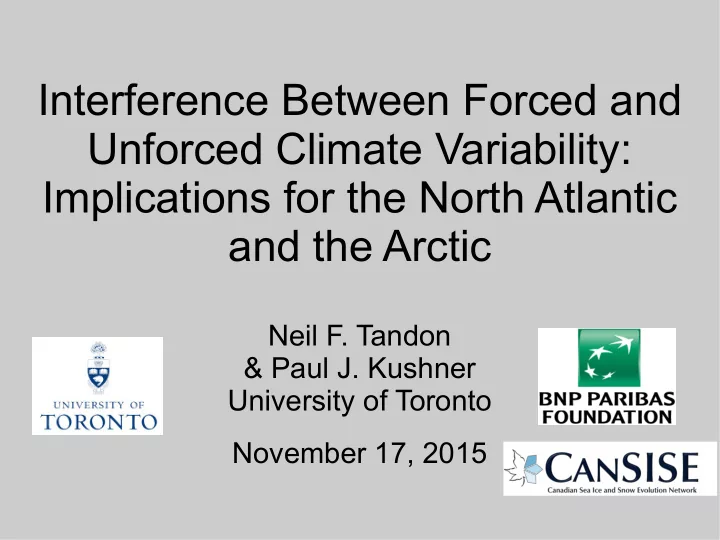

Interference Between Forced and Unforced Climate Variability: Implications for the North Atlantic and the Arctic Neil F. Tandon & Paul J. Kushner University of Toronto November 17, 2015
AMOC-NASST Relationship schematic adaptation from Delworth et al., J. Clim. (1993) Liu et al., Science (2009) (AMOC = Atlantic meridional overturning circulation NASST = North Atlantic sea surface temperature)
Models are highly inconsistent! Historical simulations (1850-2005) from CMIP5, Linearly detrended 3 Zhang and Wang, JGR (2013) cf. Medhaug and Furevik (2011)
Models are highly inconsistent! Historical simulations (1850-2005) from CMIP5, Linearly detrended 4 Zhang and Wang, JGR (2013) cf. Medhaug and Furevik (2011)
Key question #1: Why do models seem so inconsistent in how they represent the AMOC-NASST relationship? Our answer: Forced variations are interfering with unforced variations. Key question #2: Does such interference occur in the Arctic? Our answer: Apparently yes, but the effect is more regional, e.g. East Atlantic Pattern's relationship to Arctic sea ice. 5
Role of External Forcing stronger AMOC stronger weaker ocean poleward stratification* heat transport external forcing warmer cooler NASST NASST external forcing increased weaker ocean poleward stratification* heat transport weaker AMOC * or some combination of feedbacks 6
CESM1 Large Ensemble (Described in Kay et al., BAMS, 2014) 29 realizations 1920-2005 –– ensemble mean –– CMIP5 mean –– ERSSTv3 Possible role of aerosols? Implications for NASST persistence 7 Tandon and Kushner, J. Clim. (2015)
CESM1 Large Ensemble –– individual realizations –– correlation between ensemble means Implication for decadal predictability: Don't expect the AMOC to tell you what will happen to NASST! Similar behaviour in other models. lag [years] 8 Tandon and Kushner, J. Clim. (2015)
Implications for the Arctic? 1000-year control run of GFDL CM2.1 Mahajan, Zhang, Delworth, J. Clim. (2011) 9 Key point: Fairly weak AMOC influence on Arctic sea ice.
East Atlantic Pattern (EAP) (positive phase = cyclone over Labrador Sea) Unforced “Subpolar Gyre” effect: positive EAP → stronger SPG → warmer Labrador Sea/colder Arctic → ice loss in Labrador Sea/ice gain in Arctic Forced “Arctic melt” effect: forced warming → ice loss in Arctic → equatorward shift of Atlantic eddy-driven jet → positive EAP 10
EAP-SIC Correlation (CanESM2, Feb-Mar-Apr averages) (145-year chunks) Control Historical runs (detrended) (SIC = sea ice concentration 11 thick contour = 95% statistically significant)
Summary ● External forcing can interfere with internally generated covariations of the AMOC and NASST. ● There is also evidence of forced-unforced interference in the relationship between the East Atlantic Pattern and Arctic sea ice. ● Thus, one needs to be careful if attempting to predict changes in SST and sea ice based on circulation changes in the atmosphere and ocean. ● Large initial-condition ensembles are extremely helpful for separating forced and unforced effects. (Linear detrending is not the way to go!) N. F. Tandon and P. J. Kushner, 2015: Does external forcing interfere with the AMOC's influence on North Atlantic sea surface temperature? J. Climate , 28, 6309-6323, doi:10.1175/JCLI-D-14-00664.1. 12
Extra slides 13
Evidence from Other Models Historical simulations (1860-2005) Pre-industrial controls (146-year chunks) detrended annual mean detrended annual mean Tandon and Kushner, J. Clim. (2015) 14
Role of the Subpolar Gyre SPG index correlation with barotropic streamfunction (FMA) A. Born 15
Role of the Subpolar Gyre SPG index correlation with SIC (FMA) 16 Tandon and Kushner, in prep. cf. Hátún et al., Science (2005)
Regional Effects AMOC-NASST simultaneous correlation (Annual mean) Historical simulations Pre-industrial controls 17
Effect of External Forcing lag [years] lag [years] 18
Implications for Predictability 19
CESM1 Large Ensemble 20
Interference of Forced Variations? SPG-SIC correlation (FMA) Pre-industrial controls Historical simulations ...not strongly 21
AMOC & Extratropical NASST 22
Role of Atmospheric Circulation 23 Deser and Teng, GRL (2008)
Role of the Subpolar Gyre SPG index correlation with SIC (ASO) 24
Recommend
More recommend